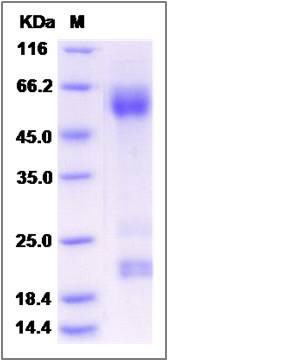Rat ADAM17 Protein (His Tag)
ADAM17, Tace
- 100ug (NPP2884) Please inquiry
| Catalog Number | P80350-R08H |
|---|---|
| Organism Species | Rat |
| Host | Human Cells |
| Synonyms | ADAM17, Tace |
| Molecular Weight | The recombinant rat ADAM17 comprises 557 amino acids and predicts a molecular mass of 63 kDa. The apparent molecular mass of the recombinant protein is approximately 57 and 20 kDa in SDS-PAGE under reducing conditions due to glycosylation. |
| predicted N | Pro 18 |
| SDS-PAGE |  |
| Purity | (73.2+23.7) % as determined by SDS-PAGE |
| Protein Construction | A DNA sequence encoding the rat ADAM17 (Q9Z1K9) (Met1-Asp563) was expressed with a polyhistidine tag at the C-terminus. |
| Bio-activity | Measured by its ability to cleave a fluorogenic peptide substrate Mca-PLAQAV-Dpa-RSSSR-NH2 (Catalog # ES003). The specific activity is >250 pmol/min/µg. |
| Research Area | Developmental Biology |Metabolism |Types of disease |Metabolism in Cancer |
| Formulation | Lyophilized from sterile PBS, pH 7.4 1. Normally 5 % - 8 % trehalose, mannitol and 0.01% Tween80 are added as protectants before lyophilization. Specific concentrations are included in the hardcopy of COA. |
| Background | ADAM17 is a member of the ADAM protein family of disintegrins and metalloproteases. ADAM17 is ubiquitously expressed in the human colon, with increased activity in the colonic mucosa of patients with ulcerative colitis, a main form of inflammatory bowel disease. The expression of ADAM17 may be inhibited by ethanol. It is involved in the processing of tumor necrosis factor alpha (TNF-α) at the surface of the cell, and from within the intracellular membranes of the trans-Golgi network. ADAM17 also plays a role in the release of a diverse variety of membrane-anchored cytokines, cell adhesion molecules, receptors, ligands, and enzymes. ADAM17 may play a prominent role in the Notch signaling pathway, during the proteolytic release of the Notch intracellular domain (from the Notch1 receptor) that occurs following ligand binding. |
| Reference |
